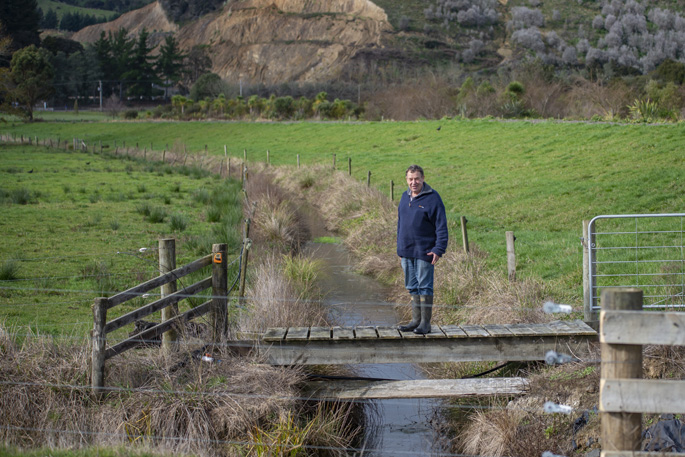Loch Carron Farm, at Island Block Rd in the Whangamarino Wetland, has been in 67-year-old Peter Buckley’s family since 1929, when his grandfather Thomas Buckley acquired 250ha of land as payment for a bad debt.
Thomas’ son – also Peter’s father – 16-year-old Tuppy ‘Malcolm’ Buckley was given 100ha and his father’s financial help. “He bought 20 milking Shorthorns from the Pokeno sales and drove them to the land, swimming the Whangamarino River on the way,” says Peter.
Each morning Tuppy milked his cows, then used them as draught animals to break in his swampy land. “The 1930s brought roads and more people to the area.”
In 1938, Tuppy married his first wife June, and had 10 children over two marriages, with Peter being the second eldest of the second marriage to Marjorie.
Peter trained as a boiler maker/welder on the railways in Otahuhu, and then spent a year in the UK. None of his siblings were interested in farming, so Peter bought a one-third share from his parents in 1974 and the other two-thirds when he married his wife Judy, in 1976.
“By then the 1966 Island Block District Drainage scheme was really showing results, and much of our wetland was well developed pasture.”
The 1950s floods
The 1950s floods had completely washed out the infrastructure and the Government, keen to support agriculture, had stepped in with subsidies to drain the swamp.
By 1974, the farm milked 250 mainly-Friesian cows, to show a profit. “I didn’t want to spend seven hours a day in a milking shed,” says Peter.
After reducing the herd to 180, Peter soon learnt that production increased because they could afford to feed the cows more. This led to a lifetime of environmentally-sympathetic farming – a concept well-ahead of its time back then.
“By the end of the 1970s, we’d beaten our best ever milk production, with a herd of 200 eating only pasture and hay.”
Peter understood that looking after the environment could save money and keep production high. The farm’s super phosphate inputs have been reduced over the years from 82 tonnes to 16 tonnes in the 2017/2018 season.
“The farm is chequered with manmade drainage channels, with water level probes that automatically kick in the flood pumps when the water level rises, or can be overridden in the drier summer.” Four powerful flood pumps can pump out water at 6m3 per second.
Peter foresaw that issues were coming down the track that could be very contentious, such as water quality, and started looking at these on his own farm. “If we used our inputs effectively, applying only what was needed, nothing would leach into the waterways.”
Today, the farm’s nitrogen reference point is 20, and 20kg/ha of nitrogen is applied straight behind the cows in spring.
Fenced waterways
All the artificial waterways were fenced before it became compulsory, and they are now home to fish and eels, indicating a healthy ecosystem.
Two naturally modified creeks supply the stock water, and the water is treated with UV light and chlorine due to high levels of E. coli.
The north sides of the drains are planted to provide shade, and weed in the drains slows sediment loss. In partnership with Kerry Reilly, from the adjoining Winstone Aggregates quarry, Peter and Judy took 4.5ha out of production to plant an extensive wetland area. This takes discharge from both the quarry and the farm, naturally filtering it and releasing it back into the Whangamarino Wetland.
The water pumped up over the stopbanks is at a higher level than much of the farm, and the ponds are crystal clear with negligible nitrates, phosphate or sediment, but some E. coli from the wetland birds.
The farm has a System 1 production system, but closer to a System 2 if they have to buy in emergency palm kernel. “The land hasn’t been re-grassed since 1981, and there are still areas of pasture originally planted in 1929.”
The cows are on a 25-day round in spring and summer, lengthening to 100 days in winter. About 170 tonnes of silage, and around 100 round bales of hay are grown on a 12-ha run-off block.
Effluent is used over the whole farm at 5ml. Dung beetles have recently been introduced, and in two to three years, their dung-burying habits will greatly improve the soil structure and root architecture.
New owners
Peter and Judy retired in June, and still live in the house they built in 1976, now on a 4ha block. New owners, apiarists Bill and Margaret Bennett, are committed to the ongoing upkeep of the farm, and position hives near to the Manuka there. They are committed to dairy farming as Peter used to.
As for Peter, he still walks the stopbanks, and is actively involved in further environmental work that may be carried out on Loch Carron Farm.



0 Comments
Leave a Comment